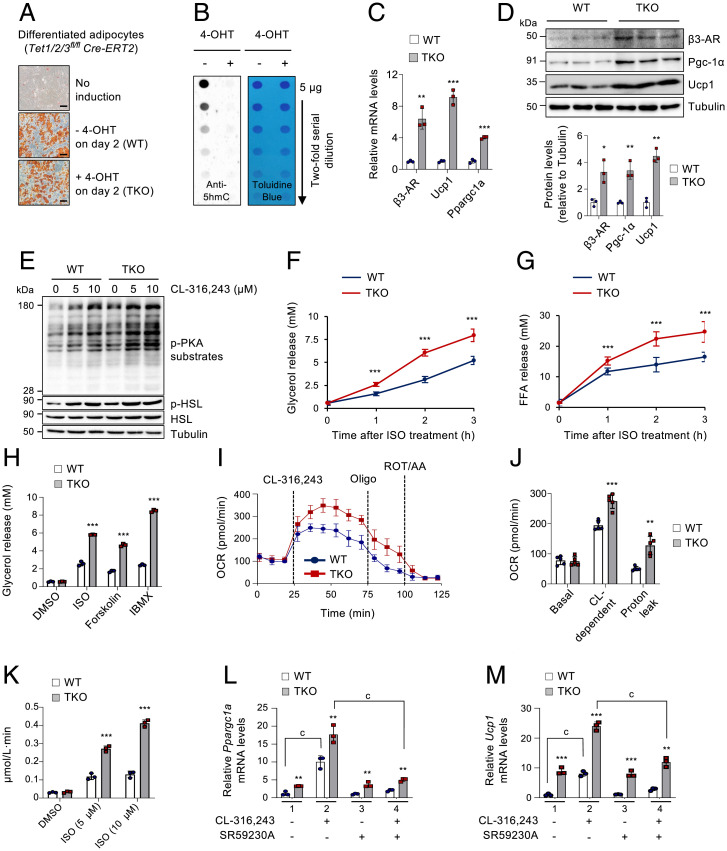Fig. 1.
TET deficiency increases β-adrenergic responsiveness by up-regulating β3-AR expression in adipocytes. (A) Oil Red O staining of differentiated WT and Tet TKO adipocytes. Preadipocytes were treated with or without 4-OHT on day 2 of differentiation. n = 3. (Scale bar, 100 μm.) (B) Dot blot analysis to quantify genomic 5hmC in WT and Tet TKO adipocytes shown in A. Toluidine blue staining confirmed blotting of equal amounts of DNA. (C) mRNA expression of β3-AR, Ucp1, and Ppargc1a relative to Gapdh in WT and Tet TKO adipocytes. n = 3. (D) Immunoblot analysis (Top) and quantification (Bottom) of β3-AR, Pgc-1α, and Ucp1 proteins in WT and Tet TKO adipocytes. α-Tubulin served as a loading control. n = 3. (E) Immunoblot analysis of p-PKA substrates, p-HSL, and total HSL proteins in WT and Tet TKO adipocytes stimulated with or without CL-316,243 for 5 min at the indicated concentrations. α-Tubulin served as a loading control. (F and G) In vitro lipolysis in WT and Tet TKO adipocytes. The released glycerol (F) and free fatty acid (G) were quantified at the indicated time points after stimulation with ISO (5 μM). n = 3. (H) In vitro lipolysis in WT and Tet TKO adipocytes stimulated with ISO (5 μM), forskolin (20 μM), or isobutylmethylxanthine (IBMX) (0.2 mM). n = 3. (I and J) Oxygen consumption rate (OCR) (I) and average OCR (J) in WT and Tet TKO adipocytes sequentially stimulated with CL-316,243 (10 µM), oligomycin (oligo; 1.25 µM), and rotenone/antimycin A (ROT/AA, 1 µM). n = 5. (K) In vitro fatty acid oxidation in WT and Tet TKO adipocytes stimulated with ISO at the indicated concentrations. n = 3. (L and M) mRNA expression of Ppargc1a (L) and Ucp1 (M) relative to Gapdh in WT and Tet TKO adipocytes stimulated with or without CL-316,243 (1 μM, 24 h). Cells were either untreated or pretreated for 1 h with SR59230A (10 μM), a β3-AR antagonist, prior to CL-316,243 treatments. n = 3. All data are presented as the mean ± SD. The P values were determined by unpaired Student’s t test. **P < 0.005, ***P < 0.0005 versus WT; cP < 0.0005. DMSO, dimethyl sulfoxide; CL, CL-316,243.

